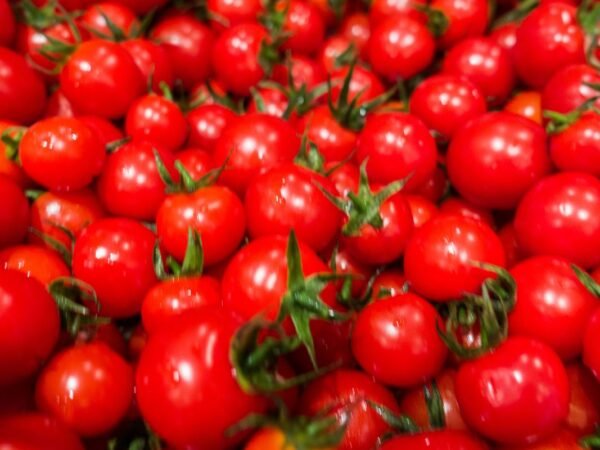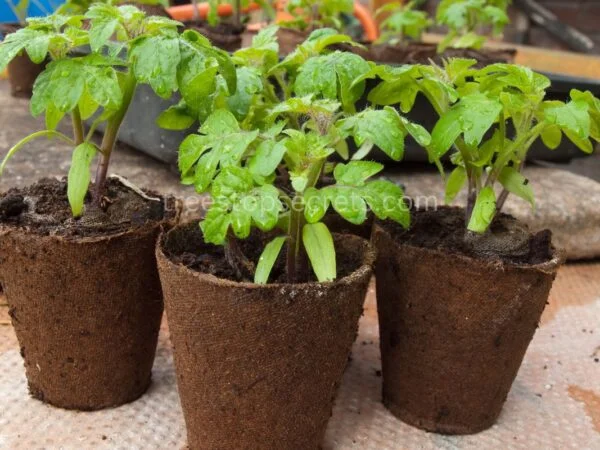Knowing how far apart to plant your tomatoes can mean the difference between a bumper crop and a garden flop. The right approach combines research-backed spacing methods with an understanding of your unique garden conditions. A strategic production plan accounts for air circulation, sunlight access, and root growth—all crucial for robust health and high yields in tomato plants. Dive into this guide to discover the best spacing practice that could transform your next harvest.
Whether you're new to gardening or looking to refine your technique, acknowledging the impact of proper spacing is key. It's not just about giving plants room; it's about optimizing every factor from disease prevention to nutrient absorption for a thriving tomato paradise.
Understanding Tomato Plant Varieties
Determinate Tomatoes
Determinate tomatoes are bush-type plants. They grow to a certain height and then stop. This makes them ideal for compact gardens where space is limited. When planting determinate tomatoes, spacing is crucial for healthy growth.
For these varieties, you should plant them about 18 to 24 inches apart in rows. The rows themselves should be spaced about 3 feet apart. This spacing allows each plant enough room to grow without competing for nutrients or sunlight.
-
Ideal spacing: 18-24 inches between plants
-
Row spacing: About 3 feet apart
These tomatoes have the advantage of not needing much pruning. It means less work for gardeners and more space saved due to their contained growth habit.
Indeterminate Tomatoes
In contrast, indeterminate tomatoes continue growing throughout the season. They can become quite large and require more space than their determinate counterparts because of their sprawling vines.
When planting indeterminate tomato varieties, consider giving them at least 24 to 36 inches between plants. Rows should be spaced about 4 feet apart to accommodate their size and need for air circulation.
-
Minimum plant spacing: 24-36 inches
-
Recommended row spacing: About 4 feet
Because they grow taller and wider, staking or caging is often necessary with indeterminate types. Proper support prevents branches from breaking under the weight of fruit and helps manage the plant's shape as it grows.
Spacing also affects disease management with indeterminate tomatoes; better airflow around each plant reduces moisture retention that can lead to fungal diseases like blight or mildew.
Ideal Spacing for Tomato Plants
In-Ground Planting
When planting tomatoes in the ground, soil preparation is key. You must consider how roots expand. This affects how far apart your tomato plants need to be. Good soil lets roots spread without crowding.
Ample space means bigger, healthier plants. A common guideline is about 24 to 36 inches apart. This allows each plant room to grow wide and tall.
Raised Beds
Raised beds offer efficient spacing for tomatoes. They have better drainage which keeps roots healthy. With raised beds, you can often plant tomatoes closer together.
In these beds, aim for 18 to 24 inches between plants. The improved soil condition in raised beds supports this closer arrangement.
Accessibility is another benefit of raised beds. It's easier to reach every plant without stepping on the soil and compacting it.
Containers
Container size will dictate your tomato plant spacing strategy. Large pots allow more root growth and thus wider spacing between containers may be needed.
The mobility of containers offers a big advantage too. You can move plants as needed for sunlight or protection from elements. Watering frequency also ties back to pot size and material—more porous materials like clay require more frequent watering than plastic or resin containers with better moisture retention. Here are some quick tips:
-
Use at least a 5-gallon container per tomato plant.
-
Space containers so leaves barely touch when fully grown.
Tomato Spacing Techniques
Single Row Method
Proper tomato spacing is crucial for healthy plants and a bountiful harvest. The single row method offers many benefits. Plants receive plenty of sunlight, as each tomato has equal access to the sun's rays. Maintenance becomes easier because there's clear space between rows.
In this approach, tomatoes are planted in one straight line with gaps between them. This arrangement allows for easy walking and working around each plant. It simplifies tasks like pruning, staking, and harvesting. Plus, it ensures that each tomato gets its fair share of light without shading neighbors.
Staggered Row Method
Another effective technique is the staggered row method. This layout increases the number of plants you can grow in an area without causing overcrowding issues. By offsetting the rows, lower leaves get better light penetration which is vital for photosynthesis.
The staggered pattern also improves airflow among plants which helps prevent diseases that thrive in damp conditions. When planting tomatoes this way, imagine a zigzag or diamond pattern from above where every other row starts with a gap.
-
Benefits include:
-
More efficient use of space
-
Enhanced sunlight exposure
-
Better air circulation
This method strikes a balance between density and healthiness of your tomato garden.
Vertical Gardening
For those with limited ground space, vertical gardening is an innovative solution to fit more tomatoes into your garden area by growing them upwards instead of outwards using various support structures like cages or trellises.
Vertical gardening not only saves space but can also lead to higher yields per square foot since you're effectively expanding the growing area available within the same footprint on the ground.
To succeed with vertical gardening:
-
Choose varieties suitable for vertical growth.
-
Invest in strong supports that can handle mature plant weight.
-
Regularly tie up new growth to keep vines secure and off the ground.
These steps ensure stability for your upward-bound tomato plants while maximizing their potential yield within minimal horizontal spaces.
Importance of Proper Spacing
Air Circulation
Tomato plants need enough space to breathe. Crowded conditions can lead to diseases. Good air flow keeps the leaves dry and healthy.
When tomatoes are too close, moisture lingers on their leaves. This creates a home for fungi. Plants with dry foliage are less likely to get sick.
Sunlight Exposure
Each tomato plant requires sunlight. Without it, they can't make food or grow fruit properly. When planted too close, one plant might block another's light.
Proper spacing prevents shadow casting between plants. It ensures all leaves have access to sun rays necessary for photosynthesis.
Root Growth
Roots spread out in search of nutrients and water in the soil. If tomato plants are too close together, their roots may compete for these essential resources.
Giving each plant enough room below ground is crucial for a strong root system which supports above-ground growth.
Maximizing Growth Potential
Nutrient Access
Plants need room to grow. Tomato plants are no different. They need space for roots to spread out and absorb nutrients. When planted too close, they fight for the same food. This can make them weak and produce less fruit.
Each tomato plant needs its own feeding zone. Think of it as a personal plate at dinner; everyone gets enough to eat without reaching over each other's meals. With proper spacing, tomatoes get all the minerals they need from fertilizers without competition.
Water Management
Water is key for healthy tomatoes but too much is trouble. Plants spaced well help manage water better. It lets soil drain so roots don't sit in water and rot.
When tomatoes have space, watering them is easier and more even. Each plant gets its share of water without stealing from its neighbor or causing puddles that lead to erosion around their stems.
Support Structures
Growing up requires support—for tomato plants at least! Cages, stakes, or trellises keep them upright as they reach for the sun.
But these supports need room too! If placed too close together, it's harder to install them properly which can make your garden look messy and unstable—especially with tall varieties that sway in the wind like trees during a storm!
Supports also affect nearby plants if not spaced right; squeezing everything together means less air flow and sunlight for everyone involved.
Disease and Pest Prevention
Spacing Influence
Tomatoes need room to grow. Proper spacing can lead to larger, healthier fruits. It's a balance between fitting as many plants as possible and giving them enough space. Too close, and the tomatoes might be small or poor in quality.
Gardeners must think about how much space they have. More space means fewer plants but potentially better produce. Also, consider the work involved. Plants that are too close together are harder to care for.
Monitoring Health
Well-spaced tomato plants help gardeners spot pests early on. If bugs attack your tomatoes, you'll see them sooner if each plant has its own area. This helps stop pests from spreading.
Diseased leaves also stand out when there's enough space between plants. You can remove sick leaves quickly before the problem gets worse. Plus, when it’s time to treat your plants with sprays or solutions, you won’t risk contaminating nearby healthy ones.
Preventative Measures
To prevent disease in your tomato garden, think about distance between plants:
-
Keep at least 24 inches between tomato plants.
-
This reduces risk of diseases like blight spreading.
-
Integrated pest management benefits from this strategy too.
Crop rotation is easier with good spacing practices:
-
Don't plant tomatoes in the same spot every year.
-
Use different areas of your garden each season.
-
This stops diseases from taking hold where tomatoes were planted before.
Signs of Improper Spacing
Overcrowding Symptoms
Tomatoes need room to thrive. Overcrowding can lead to problems. Poor air flow and light are common signs. Plants may look small and cramped together. They could struggle to grow properly.
Diseases spread fast in tight spaces. Pests find it easier to move between plants too close together. Stress from these issues weakens tomato plants, making them more vulnerable.
Factors Affecting Plant Health
Soil Quality
Good soil is key for healthy tomato plants. The soil composition affects roots. It decides how much space each plant needs. If the soil is rich and loose, roots spread well. They need room to grow.
Adding compost helps in tight spaces. This makes the soil better for more plants close together. But even with good soil, plants can't be too close. They need nutrients without fighting neighbors.
Fertile ground means you can space tomatoes closer but not too much. Each plant still needs its own area to thrive.
Climate Conditions
Humidity matters a lot for spacing tomatoes. In damp areas, leaves stay wet longer which can cause mildew or disease if plants are too close together.
Wind also plays a part in how far apart to plant tomatoes because it affects staking and supports that might be needed as they grow taller and heavier with fruit.
Hotter temperatures mean faster growth which could require adjusting spacing over time so that each tomato has enough room to mature properly without being overcrowded by its peers.
Plant Care
Smart placement saves time when caring for your garden because it allows easy access between rows or groups of tomato plants making tasks like pruning watering and harvesting simpler and more efficient overall;
Accessing Plants for Maintenance
Pruning Accessibility
Proper spacing is key to plant health. It allows gardeners to reach every tomato plant. When plants are too close, it's hard to prune them. You need room to move and see what you're doing.
Pruning helps plants grow strong. It removes parts that are dead or dying. This stops disease from spreading in your garden. To do this well, you need access from all sides of the plant.
Imagine trying to prune a crowded plant area. You might accidentally harm the good parts of nearby tomatoes. That's why space matters so much.
Conclusion
By now, you've got the dirt on how to give your tomato plants the space they crave. Whether you're working with heirlooms or hybrids, proper spacing is key to healthy, bumper crops. We've walked through spacing techniques and why elbow room matters—from dodging diseases to easing your garden chores. Keep in mind that tight quarters are a no-go; they'll only invite trouble.
So, what's next? Roll up your sleeves and mark out your patch with confidence. Give those tomatoes their personal bubble, and watch them thrive. And hey, if you hit a snag or just want to brag about your harvest, we're all ears. Share your stories and spread the green-thumb love. Ready to grow like a pro? Let's dig in!
Frequently Asked Questions
How far apart should tomato plants be spaced in a garden?
Tomato plants typically thrive when spaced about 18 to 24 inches apart. This allows ample room for growth and air circulation.
Does the variety of tomato affect how much space is needed between plants?
Yes, different varieties have unique needs. For instance, sprawling indeterminate types may need more space than compact determinates.
What are the benefits of proper spacing for tomato plants?
Proper spacing helps maximize growth potential, reduces disease risk, and makes it easier to access plants for maintenance.
Can you explain a simple tomato spacing technique?
Sure! A common method is to plant tomatoes in staggered rows—this optimizes space and sunlight exposure for each plant.
Why is it important to prevent overcrowding among tomato plants?
Overcrowded tomatoes can compete for nutrients and light, leading to weaker growth and increased susceptibility to diseases and pests.
What signs indicate that my tomato plants are too close together?
Look out for stunted growth, poor airflow resulting in wet leaves, or difficulty accessing them without damaging neighboring foliage.
How does improper spacing affect the health of my tomato plants?
Improperly spaced tomatoes can suffer from reduced yields due to competition for water and nutrients as well as higher rates of disease transmission.
Image Source: Paid image from CANVA




